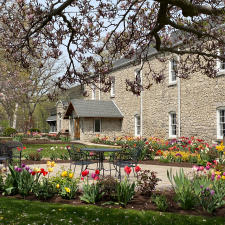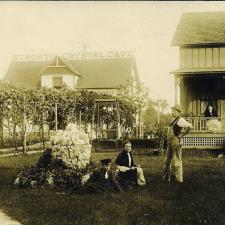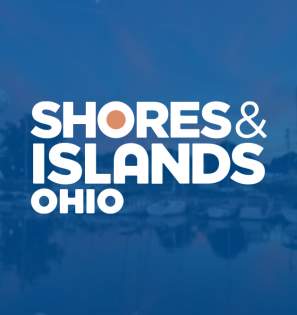Part of our Time Traveler Series
 Winemaking has a long history in Shores & Islands Ohio. The region boasts two appellations, The Lake Erie Appellation, and the only island viticultural appellation in the United States, Isle St. George (the island itself is also known as North Bass Island). The area’s climate, influenced by the lake, with cool springs and longer falls, provides perfect growing conditions. The islands accentuate the lake influence making them ideal for growing wine grapes.
Winemaking has a long history in Shores & Islands Ohio. The region boasts two appellations, The Lake Erie Appellation, and the only island viticultural appellation in the United States, Isle St. George (the island itself is also known as North Bass Island). The area’s climate, influenced by the lake, with cool springs and longer falls, provides perfect growing conditions. The islands accentuate the lake influence making them ideal for growing wine grapes.
The first grape plantings in Ohio were planted by Nicholas Longworth (often called the Father of the American Wine Industry) in Cincinnati in 1813. At first having only limited success with different varieties, the Catawba grape (and a few other American-based varietals) began producing quality wines. By the 1850s area settlers were growing grapes on Catawba (the peninsula is most likely named for this grape) and the Lake Erie Islands, primarily focusing on Catawba and other native grape varietals. The industry grew quickly, particularly after the Civil War, and by 1900 there were 17 wineries on South Bass Island alone!
 It was during these years that two of our local wine staples began. In 1872 a group of grape growers began the Catawba Island Wine Company (now known as Gideon Owen Wine Company) completing the winery in 1873. The beautiful cellars had capacity for 130,000 gallons of wine, making it one of the largest wineries in the area at the time. The initial group didn’t last long and the winery changed hands on and off over the years, culminating in Mon Ami purchasing the winery in 1937. The tradition continues as the current owners, operating as Gideon Owen Wine Company, will be growing and vinting Catawba Island wine once again in these historic cellars.
It was during these years that two of our local wine staples began. In 1872 a group of grape growers began the Catawba Island Wine Company (now known as Gideon Owen Wine Company) completing the winery in 1873. The beautiful cellars had capacity for 130,000 gallons of wine, making it one of the largest wineries in the area at the time. The initial group didn’t last long and the winery changed hands on and off over the years, culminating in Mon Ami purchasing the winery in 1937. The tradition continues as the current owners, operating as Gideon Owen Wine Company, will be growing and vinting Catawba Island wine once again in these historic cellars.
Not to be outshined, the islands and Sandusky boasted many vineyards of their own. In fact, the islands’ wine history goes back even further than Catawba Island. While Lonz may be the name most associated with Middle Bass Island, it  was actually a man named Andrew Wehrle who vinted and bottled the first wines on the islands in 1859. Wehrle owned the Golden Eagle Wine Company. The winery was very successful for a number of years, becoming one of the largest wineries in the nation; but when Andrew’s son took over the business, it failed and was auctioned off, later becoming the site for Lonz winery. A few years later, in 1888, Gustav Heineman began producing wines at Put-in-Bay. The winery (and many others on the islands) prospered through prohibition. Heineman Winery survived by selling juice (as did many wineries in the region) but had the additional income from Crystal Cave (as well as another large geode/cave which was sold). Heineman’s survived and is now the oldest family-operated winery in Ohio!
was actually a man named Andrew Wehrle who vinted and bottled the first wines on the islands in 1859. Wehrle owned the Golden Eagle Wine Company. The winery was very successful for a number of years, becoming one of the largest wineries in the nation; but when Andrew’s son took over the business, it failed and was auctioned off, later becoming the site for Lonz winery. A few years later, in 1888, Gustav Heineman began producing wines at Put-in-Bay. The winery (and many others on the islands) prospered through prohibition. Heineman Winery survived by selling juice (as did many wineries in the region) but had the additional income from Crystal Cave (as well as another large geode/cave which was sold). Heineman’s survived and is now the oldest family-operated winery in Ohio!
 While the islands offer exceptional climate with cool springs and warm, lengthy autumns, the shoreline has some advantages of its own, with the lake offering similar qualities just along the shore. Sandusky also boasted many wineries (and also breweries, but that’s for another blog). Sandusky had many wineries throughout the late 19th century and through the passing of the Volstead Act, which began prohibition. Steuk, E & K, Mantey Vineyards, and others were making quality “native” wines in Sandusky. Many of these survived through the repeal of prohibition and produced well into the 20th century. Mantey Vineyards, which was originally built in 1880, held out through prohibition, and became one of the first wineries in the area to apply for a permit after its repeal. Staying in the Mantey family until 1979, the winery was then sold and is now home to Firelands Winery. Firelands is currently one of the largest wine producers in the state. The grape industry was so important to the region that the Ohio Grape Festival was held in Sandusky in 1940.
While the islands offer exceptional climate with cool springs and warm, lengthy autumns, the shoreline has some advantages of its own, with the lake offering similar qualities just along the shore. Sandusky also boasted many wineries (and also breweries, but that’s for another blog). Sandusky had many wineries throughout the late 19th century and through the passing of the Volstead Act, which began prohibition. Steuk, E & K, Mantey Vineyards, and others were making quality “native” wines in Sandusky. Many of these survived through the repeal of prohibition and produced well into the 20th century. Mantey Vineyards, which was originally built in 1880, held out through prohibition, and became one of the first wineries in the area to apply for a permit after its repeal. Staying in the Mantey family until 1979, the winery was then sold and is now home to Firelands Winery. Firelands is currently one of the largest wine producers in the state. The grape industry was so important to the region that the Ohio Grape Festival was held in Sandusky in 1940.  Complete with a parade, a Grape Queen, local winery tours, and viticultural education, the festival highlighted what was then the top grape-producing region in the state.
Complete with a parade, a Grape Queen, local winery tours, and viticultural education, the festival highlighted what was then the top grape-producing region in the state.
Currently there are many active wineries in the region that are maintaining these age-old traditions and exploring more modern wine concepts as well! Check out the Shores & Islands Cheers Trail and have a taste of history!



